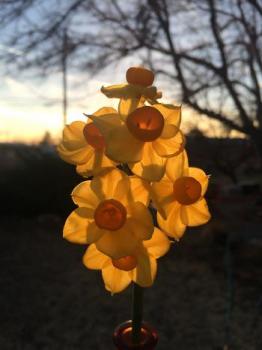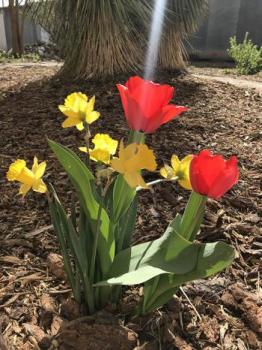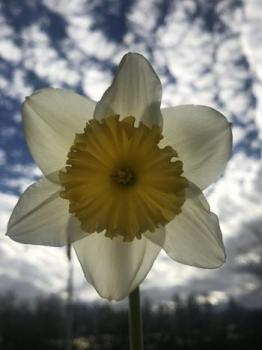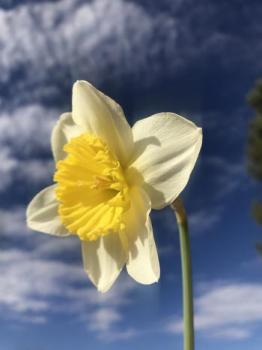January 5, 2019

Test, Don't Guess! Tulip Diseases and Daffodil Rotation
January 5, 2019
Question:
For the past several years, our tulips have struggled with some sort of disease. We suspect tulip fire blight. The symptoms are stunted growth; twisted, discolored foliage; discoloration of flowers. Is there anything we can do to prevent this issue from being a problem again this year?
- Dominique D., Albuquerque, NM
Answer:
It’s hard for me to know exactly what ails your tulips without having plant tissues tested. It could be the fungal pathogen Botrytis tulipae that is known to cause tulip fire blight in the Midwest, but as of now, there are no recorded cases of B. tulipae either in NMSU’s distance diagnostic system or in the National Plant Diagnostic Network National Repository for New Mexico.

Test, don’t guess! The Plant Diagnostic Clinic at NMSU main campus is a great resource. From pathogen testing to identification of weedy species and bugs, these services are free to New Mexicans as long as the samples are submitted through a county extension agent. Find your county’s NMSU Cooperative Extension Office.
Other species of Botrytis were reported in 2018 as problems in different plants, mostly in onion production, but also iris and the houseplant African violet. There have been confirmed cases in New Mexico of other fungal diseases in tulips. The fungal pathogen that causes fusarium basal rot was found in samples of pumpkins, onions, garlic, and alfalfa last year could be related to the problem in your tulips. It could also be bacterial soft rot caused by Erwinia carotovora which was reported in tulips growing in Los Alamos county back in 2010. Erwinia amylovora, a related species that causes fire blight in apples and pears was a huge problem for orchard growers last year.
Many pathogens are host-specific. That is, even if they’re rampant in the environment, they’ll only infect and affect specific plant species or families or cultivars. Did you notice problems with your tulips in earlier years or has the problem intensified over time? Depending on the pathogen you may be able to control disease simply by rotating species. Tulips and daffodils are from different families and have different disease pressures. Could you skip tulips a few seasons and try daffodils instead?
Here at the NMSU Agricultural Science Center at Los Lunas, we installed an ornamental bulb trial last month that included daffodils, bulb iris, crocus, and a few others. I was worried about planting so late (and frankly, I still am worried), but I was encouraged by seasoned gardeners who said as long as the soil is workable and isn’t frozen, many bulbs can thrive when planted late. Soil temperature at a depth of 6 inches was about 45°F on the day of planting, and this morning, under 3.5 inches of snow, I measured temperatures in the low-mid 30s. Last year I planted daffodil bulbs in Los Lunas in mid-January, and their bright blooms popped up in mid-March, right on time. Of course, that outcome could have been a fluke – I planted those bulbs at my house, so it wasn’t a formal study.

Ornamental bulbs aren’t very popular in New Mexico gardens, but I intend to change that. Daffodils and tulips I planted in Las Cruces rebloomed several years with astonishingly little water or other care. I’m eager to see how the different bulbs we planted in experimental plots affect soil health and beneficial insect populations. We’ll be monitoring for pollinating insects this winter, so stay tuned.
Another option if soils in your area are already frozen or you’re afraid it’s too late to actually plant is to force bulbs indoors. For tips on forcing bulbs to bloom indoors and then planting them outside in spring for future years, visit this week’s blog post at Desert Blooms.
Please collect leaf, root, and flower samples this season – both from the healthy and suffering tulips, stored separately – and bring them to the Bernalillo County Extension office to be sent down for analysis. If you add my name to the form, I’ll get a copy of the final report. My hope is that your tulip problems can be mitigated by letting the soil dry out more between waterings, avoiding over-fertilizing (excessive nitrogen) and thereby making the environment less hospitable to disease-causing pathogens.

Marisa Y. Thompson, PhD, is the Extension Horticulture Specialist, in the Department of Extension Plant Sciences at the New Mexico State University Los Lunas Agricultural Science Center, email: desertblooms@nmsu.edu, office: 505-865-7340, ext. 113.
Links:
For more gardening information, visit the NMSU Extension Horticulture page at Desert Blooms and the NMSU Horticulture Publications page.
Send gardening questions to Southwest Yard and Garden - Attn: Dr. Marisa Thompson at desertblooms@nmsu.edu, or at the Desert Blooms Facebook page.
Please copy your County Extension Agent and indicate your county of residence when you submit your question!